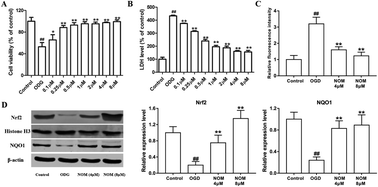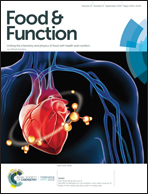Nomilin protects against cerebral ischemia–reperfusion induced neurological deficits and blood–brain barrier disruption via the Nrf2 pathway
Abstract
Oxidative stress is considered to play an important role in the cerebral ischemia–reperfusion injury. The nuclear transcription factor erythroid-2-related factor 2 (Nrf2)/NAD(P)H dehydrogenase [quinone] 1 (NQO1) pathway has been considered as a potential target for neuroprotection in cerebral ischemia–reperfusion injury. Nomilin (NOM) is a limonoid compound obtained from the extracts of citrus fruits. The purpose of our study was to determine whether NOM could exert beneficial effects in cerebral ischemia–reperfusion rats. Firstly, NOM treatment significantly mitigated cell death and decreased lactate dehydrogenase (LDH) release and ROS production in SH-SY5Y cells induced by oxygen–glucose deprivation (OGD), which was almost abolished by Nrf2 knockdown. Secondly, NOM improved infarct area, brain edema and neurological deficits in an experimental stroke rat model via middle cerebral artery occlusion (MCAO). Furthermore, NOM attenuated blood–brain barrier (BBB) disruption in MCAO rats, which might be associated with alleviating the loss of tight junction proteins, including ZO-1 and occludin-5. Further results revealed that NOM treatment effectively mitigated oxidative stress and facilitated the expressions of Nrf2 and NQO1, which might confirm that the loss of tight junction proteins in the microvasculature was likely mediated by oxidative stress. In conclusion, our study provided evidence that the protective effects of NOM in cerebral ischemia–reperfusion rats were related to the Nrf2/NQO1 pathway.



 Please wait while we load your content...
Please wait while we load your content...